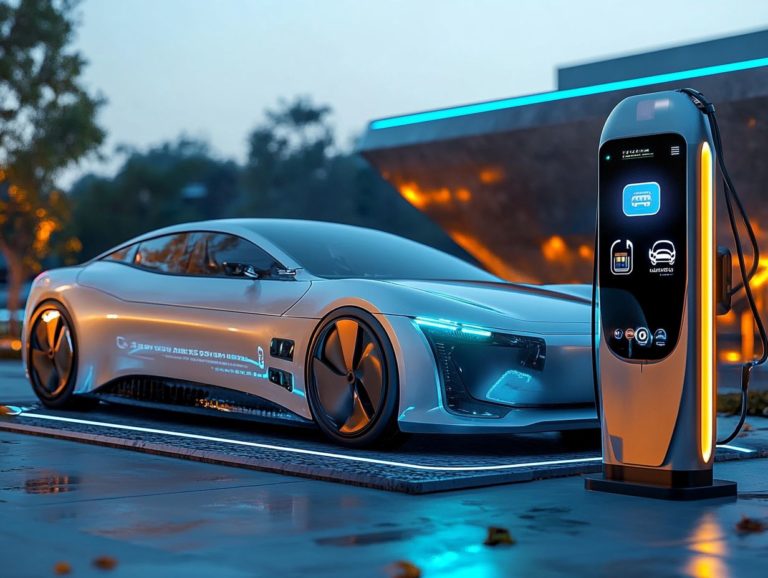5 Common FAQs About EV Charging
.jpg_11.jpeg)
Curious about how quickly you can charge your EV? With electric vehicles (EVs) gaining popularity, you probably have many questions about charging.
How long does it take to charge an EV? What charging options are available? How does the cost compare to traditional fuels? This article answers these questions, focusing on home charging, public stations, and environmental benefits.
Whether you’re considering your first EV or just exploring, you’ll find valuable information here to help you make informed decisions.
Contents
- Key Takeaways:
- 1. How Long Does It Take to Charge an Electric Vehicle?
- 2. What Are the Different Types of EV Charging?
- 3. How Much Does It Cost to Charge an Electric Vehicle?
- 4. Can I Charge My EV at Home?
- 5. Are Public Charging Stations Available?
- What Are the Benefits of Owning an Electric Vehicle?
- What Are the Environmental Benefits of Electric Vehicles?
- What Are the Common Concerns About EV Battery Life?
- How Can One Calculate the Savings of Switching to an Electric Vehicle?
- Frequently Asked Questions
- What is EV charging?
- Why should I use EV charging instead of traditional gas stations?
- Do I need a special charging unit for my electric vehicle?
- How long does it take to fully charge an electric vehicle?
- Can I charge my electric vehicle at any charging station?
- Is it safe to leave my electric vehicle charging overnight?
Key Takeaways:
- Charging time varies by charger type and battery size, ranging from 30 minutes to several hours.
- Three main types of EV charging exist: Level 1, Level 2, and DC Fast Charging, each with unique speeds and capabilities.
- Charging costs depend on electricity rates and charger type, but it’s usually cheaper than gas.
- You can charge your EV at home using Level 1 or Level 2 chargers, making it convenient and cost-effective.
- Public charging stations are becoming more accessible, easing travel for EV owners.
1. How Long Does It Take to Charge an Electric Vehicle?
Understanding charging time is crucial, whether you’re buying an EV or already have one. This knowledge affects the convenience and usability of electric mobility.
Charging time is influenced by charger type—Level 1, Level 2, or Level 3—as well as battery size and current type (AC or DC). This uncertainty can lead to range anxiety, hindering EV adoption.
Level 1 chargers use standard outlets and can take 8 to 20 hours for a full charge, which may not fit your daily routine. Level 2 chargers, found in public stations and some homes, can charge in 4 to 8 hours.
If you’re in a hurry, Level 3 or DC fast chargers can recharge up to 80% in just 30 minutes, using direct current for quick energy transfer. Knowing these options helps you plan your charging and alleviate range anxiety.
2. What Are the Different Types of EV Charging?
EV charging offers several options tailored to different needs. Level 1 chargers are great for overnight use at home, while Level 2 chargers provide faster charging at public stations.
DC fast chargers enable quick battery replenishment—essential for longer trips. Each charger type has its pros and cons. Level 1 is convenient and cost-effective, but might not be enough for daily commuters.
Level 2 chargers are quicker and commonly located in shopping centers and workplaces, though installation costs can be higher. DC fast chargers minimize downtime, ideal for road trips but may be pricier and less available.
When considering an EV, prioritize areas with a strong network of chargers to avoid running low on battery during your travels.
3. How Much Does It Cost to Charge an Electric Vehicle?
Understanding charging costs is vital for prospective EV buyers, as it impacts long-term expenses. Costs vary based on location (home vs. public) and charger type.
Public stations may charge around 40 euro cents or 17 cents per kWh. Assess how often you’ll rely on public versus home charging.
Exploring solar EV charging options can further reduce costs, appealing to environmentally-conscious consumers.
Energy rates differ by region; urban areas often have higher costs due to demand, while rural areas may offer better rates. Fast chargers typically cost more than standard ones, affecting your charging habits.
Generally, owning an EV leads to lower operating costs compared to traditional vehicles, especially when considering potential savings from government incentives and maintenance costs.
4. Can I Charge My EV at Home?
You can charge your EV at home, which is one of the most convenient options. You can choose a Level 1 charger using a standard outlet or a Level 2 charger for faster charging, which may need professional installation.
Home charging makes EV ownership practical, allowing you to plug in after a long day, ensuring your vehicle is ready by morning. This reliability eases concerns about finding public charging stations.
Although installing a Level 2 charger requires consideration of your electrical capacity and potential upgrades, the benefits of home charging make it appealing for many EV enthusiasts.
5. Are Public Charging Stations Available?
Public charging stations are essential for your EV experience, providing necessary recharge options. Cities are expanding their networks to reduce range anxiety.
Numerous public charging stations are available, offering various charging types and speeds to suit your needs while traveling.
Increased station availability alleviates worries about running low on power, facilitating the broader adoption of electric vehicles.
Charging networks like Blink Charging play a crucial role by investing in these infrastructures, making EV ownership more convenient.
As public charging stations grow, technology advancements enhance charging experiences, with fast-charging stations appearing in urban areas and along highways.
What Are the Benefits of Owning an Electric Vehicle?
Owning an EV provides numerous benefits, including fuel savings and environmental sustainability. Electric vehicles typically require less maintenance than traditional vehicles, translating to lower ownership costs.
Environmental benefits are compelling—EVs produce fewer emissions and smaller carbon footprints, especially as hybrid options gain traction. This makes a strong case for choosing electric vehicles today.
EV ownership can improve your finances, as many states offer tax incentives and rebates to lower initial costs, making it accessible for budget-conscious buyers.
Communities benefit from cleaner air and reduced reliance on fossil fuels. More drivers choosing electric vehicles leads to expanding charging infrastructure, enhancing convenience.
This shift promotes sustainability, encouraging businesses and municipalities to adopt greener practices, benefiting everyone. Choosing an electric vehicle is a step toward a more sustainable future.
What Are the Common Myths About EV Charging?
Many myths about EV charging persist, often deterring potential buyers. A common misconception is that charging takes much longer than refueling a gas vehicle, ignoring advancements in charging technology.
Range anxiety is another myth—many worry about finding charging stations, even though public and home charging options are increasingly available. Educating yourself helps dispel these myths and encourages electric mobility.
Studies show that over 80% of EV owners charge their vehicles at home overnight, making charging time concerns largely irrelevant. With over 130,000 public charging locations in the U.S., recharging during errands or travel is easier than ever.
Fast chargers can refill a battery in just 30 minutes, reinforcing the practicality of electric vehicles in daily life. Addressing these misconceptions clarifies the ease of transitioning to electric vehicles.
How Can EV Charging Infrastructure Be Improved?
Improving EV charging infrastructure is vital for broader EV adoption; your innovations can enhance user experience and accessibility. Smart planning is crucial for expanding charging networks.
Focus on increasing public charging stations, upgrading facilities for faster charging, and ensuring convenient locations to reduce range anxiety.
Government initiatives like grants can incentivize charging station development, and partnering with private companies secures funding and expertise. Successful models like California’s Charge! program show how collaboration can enhance charging experiences.
Smart technology advancements, like apps showing real-time station availability, improve user convenience. Implementing these strategies paves the way for a robust EV charging ecosystem, encouraging more consumers to make the switch.
What Are the Environmental Benefits of Electric Vehicles?
Electric vehicles (EVs) provide many environmental benefits, making them key to sustainable transportation initiatives. By generating zero tailpipe emissions, EVs significantly reduce air pollution compared to traditional vehicles, leading to cleaner urban areas.
When charged with renewable energy sources like solar power, you can greatly decrease your carbon footprint. Hybrid and plug-in hybrid vehicles also lessen fossil fuel dependence and improve fuel efficiency.
The advantages extend beyond emissions; EVs combat climate change by reducing greenhouse gas emissions. As renewable sources expand in the energy grid, EVs become even more environmentally friendly.
Growing consumer interest in electric mobility boosts demand for sustainable energy, driving investments in clean technologies and infrastructure needed for a greener future.
What Are the Common Concerns About EV Battery Life?
Concerns about EV battery life are common among potential buyers, often stemming from misunderstandings about battery technology. You may worry that battery degradation will affect driving range and charging time, but advancements have improved longevity.
Regular maintenance plays a key role in preserving battery health. Factors influencing battery longevity include charging practices, battery type, and environmental conditions.
For instance, frequent fast charging can accelerate wear, while maintaining optimal charging levels (20% to 80%) can help extend lifespan. Parking in temperature-controlled environments optimizes battery health.
Experts recommend regular software updates and checks to address minor issues, helping clear up myths about needing frequent battery replacements and allowing you to enjoy your EV with confidence.
How Can One Calculate the Savings of Switching to an Electric Vehicle?
Calculating savings from switching to an electric vehicle (EV) involves examining initial costs, charging expenses, and potential savings on fuel and maintenance. Although the upfront cost can be higher, lower charging expenses compared to gasoline can lead to significant savings.
Start by assessing your average annual mileage. For example, if you drive around 12,000 miles, you might spend approximately $1,600 on gasoline, depending on fuel prices.
Next, evaluate energy costs for charging, which are typically under $600 for the same mileage. Research tax credits and incentives that can enhance the financial appeal of making the switch.
This comprehensive approach reveals how transitioning to an EV can deliver tangible benefits, making it an attractive choice for your future.
Frequently Asked Questions
Explore electric vehicles further to understand their benefits, savings, and how they can fit into your lifestyle.
What is EV charging?
EV charging means recharging an electric vehicle’s battery. You can do this at home or at designated charging stations.
Why should I use EV charging instead of traditional gas stations?
EV charging is more eco-friendly and cheaper. You can also charge at home for added convenience.
Do I need a special charging unit for my electric vehicle?
It depends on your vehicle. Some can be charged using a standard outlet; others require a specialized unit. Check your vehicle’s manual or consult an electrician.
How long does it take to fully charge an electric vehicle?
Charging time varies based on battery size and charging speed, typically taking 4-8 hours at home.
Can I charge my electric vehicle at any charging station?
Check if a station is compatible with your vehicle before use. Some may require a membership or payment, so research and plan ahead.
Is it safe to leave my electric vehicle charging overnight?
Yes! It’s safe to charge overnight. Modern EVs stop charging when full and have safety features to prevent damage.

.jpg_00.jpeg)
.jpg_01.jpeg)
.jpg_10.jpeg)





